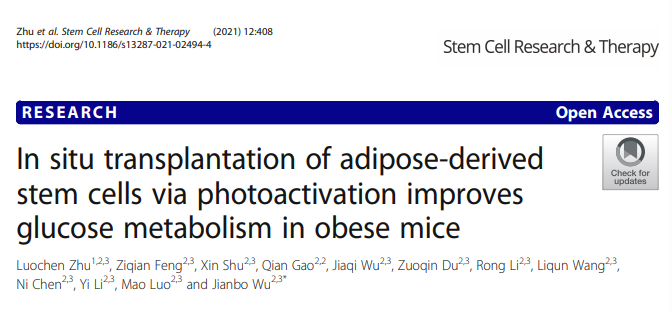2021年7月,吴剑波教授课题组在Stem Cell Res Ther杂志上发表论文

Abstract
Background:Accumulating evidence suggests that enhanced adipose tissue macrophages (ATMs) are associated with metabolic disorders in obesity and type 2 diabetes. However, therapeutic persistence and reduced homing stem cell function following cell delivery remains a critical hurdle for the clinical translation of stem cells in current approaches.
Methods:We demonstrate that the effect of a combined application of photoactivation and adipose-derived stem cells (ASCs) using transplantation into visceral epididymal adipose tissue (EAT) in obesity. Cultured ASCs were derived from subcutaneous white adipose tissue isolated from mice fed a normal diet (ND).
Results:In diet-induced obesity, implantation of light-treated ASCs improved glucose tolerance and ameliorated systemic insulin resistance. Intriguingly, compared with non-light-treated ASCs, light-treated ASCs reduced monocyte infiltration and the levels of ATMs in EAT. Moreover, implantation of light-treated ASCs exerts more anti-inflammatory effects by suppressing M1 polarization and enhancing macrophage M2 polarization in EAT. Mass spectrometry revealed that light-treated human obese ASCs conditioned medium retained a more complete secretome with significant downregulation of pro-inflammatory cytokines and chemokines.
Conclusions:These data suggest that the combined application of photoactivation and ASCs using transplantation into dysfunctional adipose tissue contribute to selective suppression of inflammatory responses and protection from insulin resistance in obesity and type 2 diabetes.
